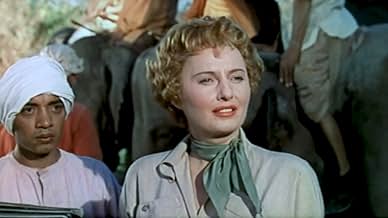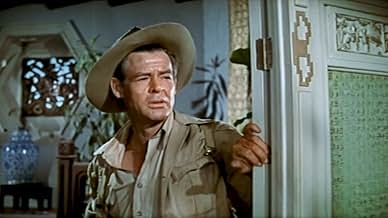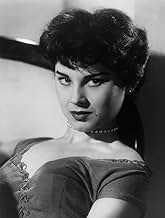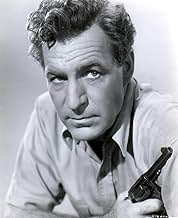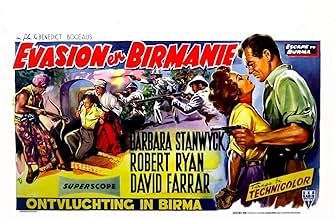ÉVALUATION IMDb
5,5/10
736
MA NOTE
Ajouter une intrigue dans votre langueA fugitive in British Burma hides on a teak plantation, thanks to a mutual attraction with owner Gwen Moore.A fugitive in British Burma hides on a teak plantation, thanks to a mutual attraction with owner Gwen Moore.A fugitive in British Burma hides on a teak plantation, thanks to a mutual attraction with owner Gwen Moore.
- Director
- Writers
- Stars
Wag Blesing
- Minor Role
- (uncredited)
Avis en vedette
it must have been quite impressive for it's time - Color film, old-time film noir star B. Stanwyck and film military hero Robert Ryan were the big attractions in this far-away-location B movie; one of the 2-movie pack in the discount bin from TCM. it DOES have crystal-clear color photography andexcellent sound. Lots of messing about with elephants and tigers, and actors reciting monotone lines; the script needed some more zing or something - not much of a plot in the first half, but it gets better as it goes along. This was made about 10 years before Stanwyck's starring role in "Big Valley". Robert Ryan redeemed himself by doing "Longest Day" and "Battle of the Bulge" after this. Directed by Allan Dwan, who had started in 1911 in silents, and had worked his way up in every occupation in the film industry.
This is a movie full of charm that I talk about helped by a splendid cast, magical score and atmosphere, despite the studio lot obvious settings. The pure example of what the fifties could bring us in terms of adventure flicks. Benedict Bogeaus provided most of last films from prolific director Allan Dwann. Robert Ryan and Barbara Stanwyck shine at their best here and the animal presence gives a delightful touch to the whole. No matter the intrigue, story, only enjoy the atmosphere. John Alton proves one more time his magical talent as director of photography. This movie is a jewel by itself, and not only those what it is question in the story.
It is one of the cliches of mainstream Hollywood cinema that the desire of the hero is limited to two options - a good girl (marriage, security, family, society), and a bad girl (lust, transgression). In this scenario, women are barely people at all, more embodiments of Law and Desire, the socially acceptable and unacceptable.
Not the least of this brilliant film's achievements is the way it transfers this cliche to the heroine, making it new and strange. It is the two male characters who represent the two options open to the woman - Robert Ryan is the outlaw, suspected murderer and jewel thief, sexually direct; David Farrer is the policeman, punctiliously obeisant to the law, sexually repressed.
Ryan hasn't stepped foot in Barbara Stanwyk's elephant ranch before he's made himself at home, made her frankly voracious and got her talking about 'marriage', which we suspect has little to do with religious ceremonies. Farrer no sooner arrives then he wants to take a man home with him. The film's most striking scene occurs near the climax, in the symbolic space of an abandoned, monkey infested Buddhist temple, the two men grappling like Lawrentian blood brothers, and Stanwyk gaping hungrily on, absolutely thrilled.
This central twist is part of the film's wider iconoclasm. Like more renowned peers (Minnelli, Sirk etc.), Dwan takes reactionary material and dismantles it. Firstly, the film offers an odd mish-mash of genres. The film is supposedly set in Burma and its environs, but this is an Orient in the tradition of Powell and Pressburger, the hero of whose 'Black Narcissus' stars here (Farrer).
Whereas 'Narcissus' was a work of complete, defiant artifice, 'Escape' offers a disturbing clash between real location footage and cramped studio sets, often within the one scene which, especially in action sequences, has a jarring, alienating effect. The most notable example occurs early on, when Ryan and Stanwyk hunt a marauding tiger - the effect takes us out of the 'realistic' adventure and alerts us to a more symbolic plane.
Although the film is set in the east, the three genres it evokes originate much further away. Even though the film is an action adventure - and a very exciting one, full of chases, gun-fights and dangerous animals - it is also a melodrama, about a lonely woman stranded in the middle of nowhere, powerful but so starved of 'companionship' she'll attach herself to the first man who comes along. Some of the lighting effects and careful compositions recall the contemporary melodramas of Sirk. The film also belongs to the jungle sub-genre, full of thick forests and animals being cute.
Most important, however, the film is a transposed Western, with Ryan as the outlaw hiding out in Stanwyk's ranch, and Farrer the sherriff sent to being him back. Except, like Ray's 'Johnny Guitar', the colour, the mise-en-scene, the extravagant sexual rituals tend to undermine macho Western self-importance; a female 'Eastern' reflecting back the male Western.
As the scene I mentioned earlier suggests - the brawl in the temple - the idea of play figures throughout, with narrative action turned into ritual or theatre, with extras, ceremonial gestures, and, most importantly, an audience. The most alarming of these is Ryan's torture, but throughout there is an emphasis on people watching, usually obscurely, through gaps and grills, or being framed in proscenium arches within the narrative frame.
Another motif alerting us to mistrust appearances is the mirror- so often a symbol of metamorphosis or revelation; actual mirrors co-exist with mirroring scenes, for example the symmetrical skulking of Stanwyk and the tiger watched by Ryan (doubly mirrored and reversed in the temple scene)
Not the least of this brilliant film's achievements is the way it transfers this cliche to the heroine, making it new and strange. It is the two male characters who represent the two options open to the woman - Robert Ryan is the outlaw, suspected murderer and jewel thief, sexually direct; David Farrer is the policeman, punctiliously obeisant to the law, sexually repressed.
Ryan hasn't stepped foot in Barbara Stanwyk's elephant ranch before he's made himself at home, made her frankly voracious and got her talking about 'marriage', which we suspect has little to do with religious ceremonies. Farrer no sooner arrives then he wants to take a man home with him. The film's most striking scene occurs near the climax, in the symbolic space of an abandoned, monkey infested Buddhist temple, the two men grappling like Lawrentian blood brothers, and Stanwyk gaping hungrily on, absolutely thrilled.
This central twist is part of the film's wider iconoclasm. Like more renowned peers (Minnelli, Sirk etc.), Dwan takes reactionary material and dismantles it. Firstly, the film offers an odd mish-mash of genres. The film is supposedly set in Burma and its environs, but this is an Orient in the tradition of Powell and Pressburger, the hero of whose 'Black Narcissus' stars here (Farrer).
Whereas 'Narcissus' was a work of complete, defiant artifice, 'Escape' offers a disturbing clash between real location footage and cramped studio sets, often within the one scene which, especially in action sequences, has a jarring, alienating effect. The most notable example occurs early on, when Ryan and Stanwyk hunt a marauding tiger - the effect takes us out of the 'realistic' adventure and alerts us to a more symbolic plane.
Although the film is set in the east, the three genres it evokes originate much further away. Even though the film is an action adventure - and a very exciting one, full of chases, gun-fights and dangerous animals - it is also a melodrama, about a lonely woman stranded in the middle of nowhere, powerful but so starved of 'companionship' she'll attach herself to the first man who comes along. Some of the lighting effects and careful compositions recall the contemporary melodramas of Sirk. The film also belongs to the jungle sub-genre, full of thick forests and animals being cute.
Most important, however, the film is a transposed Western, with Ryan as the outlaw hiding out in Stanwyk's ranch, and Farrer the sherriff sent to being him back. Except, like Ray's 'Johnny Guitar', the colour, the mise-en-scene, the extravagant sexual rituals tend to undermine macho Western self-importance; a female 'Eastern' reflecting back the male Western.
As the scene I mentioned earlier suggests - the brawl in the temple - the idea of play figures throughout, with narrative action turned into ritual or theatre, with extras, ceremonial gestures, and, most importantly, an audience. The most alarming of these is Ryan's torture, but throughout there is an emphasis on people watching, usually obscurely, through gaps and grills, or being framed in proscenium arches within the narrative frame.
Another motif alerting us to mistrust appearances is the mirror- so often a symbol of metamorphosis or revelation; actual mirrors co-exist with mirroring scenes, for example the symmetrical skulking of Stanwyk and the tiger watched by Ryan (doubly mirrored and reversed in the temple scene)
The BBC aired this recently and as it was directed by super veteran Allan Dwan I happened to tape it.
Ryan plays the typical US macho hero of the fifties, a fightin',shootin'(a Luger no less!) and kissin'guy. Mrs. Stanwyck is the owner of a plantation near Rangoon and she is not to be messed with. Third character is your run-of-the mill British, slightly repressed policeman, on the hunt for Ryan who supposedly has murdered the son of the local potentate.
If you are a fan of Dwan's work better skip this one. The only good thing about it is the crisp clear color photography, the rest is pretty embarrassing. Clichéd would be putting it mildly. The script seems to be written in an afternoon and the same can be said of the movie itself.
It is a bit unfair to Allan Dwan, as he made countless movies and still turned out some excellent stuff near the end of his very long career, as the classic marine epic "The Sands of Iwo Jima" and the sexy "Slightly Scarlet". So do not judge him on this silly jungle epic.
Ryan plays the typical US macho hero of the fifties, a fightin',shootin'(a Luger no less!) and kissin'guy. Mrs. Stanwyck is the owner of a plantation near Rangoon and she is not to be messed with. Third character is your run-of-the mill British, slightly repressed policeman, on the hunt for Ryan who supposedly has murdered the son of the local potentate.
If you are a fan of Dwan's work better skip this one. The only good thing about it is the crisp clear color photography, the rest is pretty embarrassing. Clichéd would be putting it mildly. The script seems to be written in an afternoon and the same can be said of the movie itself.
It is a bit unfair to Allan Dwan, as he made countless movies and still turned out some excellent stuff near the end of his very long career, as the classic marine epic "The Sands of Iwo Jima" and the sexy "Slightly Scarlet". So do not judge him on this silly jungle epic.
Direction, acting and virtually everything else about this mid-fifties pulp action flick are too flat to make it more than mildly enjoyable in a camp way. Ryan and Farrar fare better than Stanwyck, whose performance here unintentionally verges on self-parody. Stanwyck is very watchable here, but the script is so lazy and routine that her typical (and admirable) energy in tackling the role works against her. Ryan more appropriately gives the script its due,expressing obvious contempt for some of his lines. For a fifties flick, the quick sexual hookup of Ryan and Stanwyck is surprising (though a 10-year-old kid could see the film and not know what was happening between them).
I think this and "Cattle Queen of Montana" are Stanwyck's only color films. Black and white works better for her; the heavy makeup here makes her look inappropriately feverish, even for a jungle flick.
"Escape to Burma" is enjoyably bad in a mild way. I loved the back-lot jungle sets and obvious tropical foliage decoration. Nice house Stanwyck has there in the jungle too. Super art direction (always an RKO forte).
"Slightly Scarlet," "Silver Lode" and "The River's Edge" are far more enjoyable and interesting Allan Dwan efforts from the fifties.
I think this and "Cattle Queen of Montana" are Stanwyck's only color films. Black and white works better for her; the heavy makeup here makes her look inappropriately feverish, even for a jungle flick.
"Escape to Burma" is enjoyably bad in a mild way. I loved the back-lot jungle sets and obvious tropical foliage decoration. Nice house Stanwyck has there in the jungle too. Super art direction (always an RKO forte).
"Slightly Scarlet," "Silver Lode" and "The River's Edge" are far more enjoyable and interesting Allan Dwan efforts from the fifties.
Le saviez-vous
- AnecdotesSharon Lee's debut.
- GaffesIn the Burmese jungle temple, some of the apes are chimpanzees, which only live in Africa.
- Citations
Gwen Moore: You may mount.
- ConnexionsReferenced in The Exiles (1961)
Meilleurs choix
Connectez-vous pour évaluer et surveiller les recommandations personnalisées
- How long is Escape to Burma?Propulsé par Alexa
Détails
- Date de sortie
- Pays d’origine
- Langue
- Aussi connu sous le nom de
- Escape to Burma
- Lieux de tournage
- World Animal Jungle Compound, Thousands Oaks, Californie, États-Unis(tiger hunt scene)
- sociétés de production
- Consultez plus de crédits d'entreprise sur IMDbPro
- Durée1 heure 27 minutes
- Rapport de forme
- 2.00 : 1
Contribuer à cette page
Suggérer une modification ou ajouter du contenu manquant

Lacune principale
By what name was Les rubis du prince birman (1955) officially released in India in English?
Répondre



